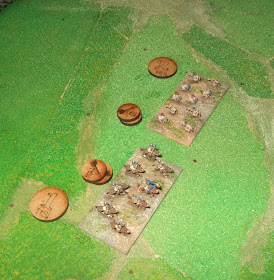What I have had time for is reading. Scattered around the place are:
- Oman, The Art of War in the Middle Ages (vol. 1)
- WRG, Armies and Enemies of Imperial Rome
- Gibbon, The Decline and Fall of the Roman Empire
- Webster, The Imperial Roman Army, and
- Bona, The Dawn of the Dark Ages: The Gepids and Lombards in the Carpathian Basin.
From which you can see that I'm on an ancients trip under the influence of To The Strongest! My current dilemma is where to concentrate my efforts. The fourth and fifth centuries are interesting with barbarians ravaging their way across a crumbling Empire. I quite fancy the Gothic war of the 370s. But then there's the middle of the third century. For twenty years from 249 there's a succession of army-proclaimed Emperors and almost constant fighting between claimants to the purple.
226 Persians overthrow Parthians. Franks, Alamanni, Goths begin to appear along the Rhine and Danube. (Oman)
236 “Onslaught of the Quadi Carpi and Goths on the middle and lower Danube” beaten back by Maximinius I and Philip. (Oman)
249 Decius overthrows Philip - civil war in Empire. Goths cross the Danube and Balkans, overrun Moesia and Thrace, scattering Imperial troops before them.
251 Goths defeat Decius (and son) art Forum Trebonii / Arbutus (Razgrad, Bulgaria). First Roman Emperor to be killed in battle with barbarians.
Goths range almost unresisted over the middle provinces of the empire for 20 years. Raid as far as Athens and Dyrrachium (Durres, Albania). Other Goth armies cross the Hellespont and sack Chalcedon, Alexandria Troas, and Ephesus (western Turkey) and Trebizond (Black Sea coast).
258 Sapor’s Persians overrun Mesopotamia and capture Valerian.
269 Battle of Naissus (Niš, Serbia), Galienus(?) defeats the Goths.
After 268 Claudius, Aurelian and Probus reconquer the west from rebel Caesars, clear the Germans out of the Balkan peninsula, win back the east from the Persians and Palmyrenes.
271 After defeating another Gothic invasion, Aurelian abandons Dacia north of the Danube to rationalise the borders of the empire.
297 Diocletian reconquers Britain.
357 Julian defeats south German tribes near Strasbourg.
376 In the summer and fall of 376, tens of thousands of displaced Goths and other tribes arrived on the Danube River, on the border of the Roman Empire, requesting asylum from the Huns. Fritigern, a leader of the Thervingi, appealed to the Roman emperor Valens to be allowed to settle with his people on the south bank of the Danube, where they hoped to find refuge from the Huns, who lacked the ability to cross the wide river in force. Valens permitted this, and even helped the Goths cross the river, probably at the fortress of Durostorum (modern Silistra), Bulgaria.
Valens promised the Goths farming land, grain rations, and protection under the Roman armies as foederati. His major reasons for quickly accepting the Goths into Roman territory were to increase the size of his army, and to gain a new tax base to increase his treasury. The selection of Goths that were allowed to cross the Danube was unforgiving: the weak, old, and sickly were left on the far bank to fend for themselves against the Huns. The ones that crossed were supposed to have their weapons confiscated; however, the Romans in charge accepted bribes to allow the Goths to retain their weapons. (Wikipedia)
378 Battle of Adrianople, Valens and 40,000 Romans killed in battle (near Edirne, Turkey/Bulgaria border).
379 Goths move into and plunder Dacia (western Romania).
380 Goths divide. Tervingi under Fritigern move into Macedonia. The Greuthungi move into Pannonia where they are defeated by Gratian.
381 Western Roman forces drive goths back into Thrace.
382 Peace agreed.




















































